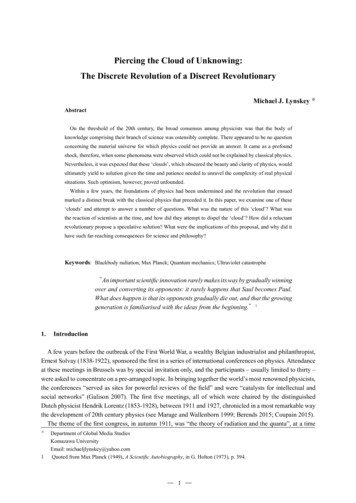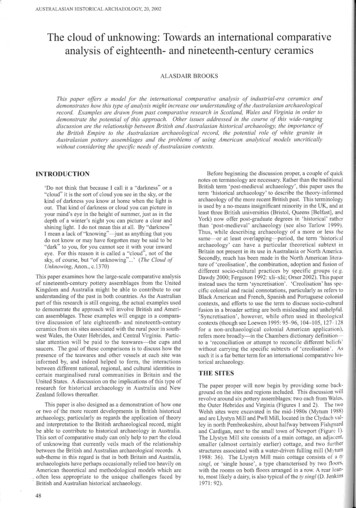
Transcription
Piercing the Cloud of Unknowing:The Discrete Revolution of a Discreet RevolutionaryMichael J. Lynskey ※AbstractOn the threshold of the 20th century, the broad consensus among physicists was that the body ofknowledge comprising their branch of science was ostensibly complete. There appeared to be no questionconcerning the material universe for which physics could not provide an answer. It came as a profoundshock, therefore, when some phenomena were observed which could not be explained by classical physics.Nevertheless, it was expected that these ‘clouds’, which obscured the beauty and clarity of physics, wouldultimately yield to solution given the time and patience needed to unravel the complexity of real physicalsituations. Such optimism, however, proved unfounded.Within a few years, the foundations of physics had been undermined and the revolution that ensuedmarked a distinct break with the classical physics that preceded it. In this paper, we examine one of these‘clouds’ and attempt to answer a number of questions. What was the nature of this ‘cloud’? What wasthe reaction of scientists at the time, and how did they attempt to dispel the ‘cloud’? How did a reluctantrevolutionary propose a speculative solution? What were the implications of this proposal, and why did ithave such far-reaching consequences for science and philosophy?Keywords: Blackbody radiation; Max Planck; Quantum mechanics; Ultraviolet catastrophe“An important scientific innovation rarely makes its way by gradually winningover and converting its opponents: it rarely happens that Saul becomes Paul.What does happen is that its opponents gradually die out, and that the growinggeneration is familiarised with the ideas from the beginning.”11.IntroductionA few years before the outbreak of the First World War, a wealthy Belgian industrialist and philanthropist,Ernest Solvay (1838-1922), sponsored the first in a series of international conferences on physics. Attendanceat these meetings in Brussels was by special invitation only, and the participants – usually limited to thirty –were asked to concentrate on a pre-arranged topic. In bringing together the world’s most renowned physicists,the conferences “served as sites for powerful reviews of the field” and were “catalysts for intellectual andsocial networks” (Galison 2007). The first five meetings, all of which were chaired by the distinguishedDutch physicist Hendrik Lorentz (1853-1928), between 1911 and 1927, chronicled in a most remarkable waythe development of 20th century physics (see Marage and Wallenborn 1999; Berends 2015; Coupain 2015).The theme of the first congress, in autumn 1911, was “the theory of radiation and the quanta”, at a time※1Department of Global Media StudiesKomazawa UniversityEmail: michaeljlynskey@yahoo.comQuoted from Max Planck (1949), A Scientific Autobiography, in G. Holton (1973), p. 394.― 1 ―
Journal of Global Media Studies Vol. 27when the foundations of physics were totally shaken (Straumann 2011). The 23 attendees included MaxPlanck (1858-1947) and Albert Einstein (1879-1955), both of whom were initiators of this disruption(Lambert 2015), although they were different temperamentally and seemed to exemplify a distinction inhuman nature made famous by Isaiah Berlin (1953) in the epigram: “the fox knows many things, but thehedgehog knows one big thing.”2 At the start of the 20th century, Planck was the most famous physicistin Germany. Conservative, modest and retiring by nature, in his research Planck seemed to personify thehedgehog, whose purpose is to know one big thing and to strive without ceasing to give reality a unifyingshape: “who relate everything to a single central vision, one system, less or more coherent or articulate, interms of which they understand, think and feel – a single, universal, organising principle in terms of whichalone all that they are and say has significance” (Berlin 1953: 2).3In contrast, Einstein, the second-youngest participant of the 1911 Solvay meeting, had achieved recognitionat the age of 26 with the publication of four ground-breaking papers, each on a different subject, and wenton to receive worldwide acclaim after confirmation of his general theory of relativity by the Eddingtonexperiment of 1919.4 In his work, Einstein appeared to characterise the fox, who pursues many ends, oftenunrelated and even contradictory, but who comes to understand that a coherent worldview is probably beyondhim - as Einstein found in his fervent pursuit of a unified field theory that, he hoped, would supplant quantummechanics (see Pais 1982; Home and Whitaker 2007; Lindley 2007; Newton 2009).The fifth Solvay congress of 1927, on the theme of “electrons and photons”, is regarded as the mostillustrious assembly of scientists in history. It was devoted to quantum theory, and was attended by no lessthan nine theoretical physicists who had made fundamental contributions to the theory, including Planckand Einstein. Each of the nine would eventually be awarded a Nobel Prize for his contribution; and, in fact,of the 29 attendees at the 1927 conference, 17 were, or would ultimately became, Nobel Prize laureates.These pioneering scientists proved the value of quantum theory by explaining a wide range of phenomena,to such an extent that it is recognised as “the most successful scientific theory ever produced” (Davies andBrown 1986: 1). Considering the time scale of the early Solvay convocations (interrupted as they were by thecataclysm of the Great War), it is no exaggeration to say that there is hardly any other period in the history ofscience in which so much was clarified by so few in so short a time.2.Two CloudsOn the threshold of the 20th century, the broad consensus among physicists was that the body ofknowledge comprising their branch of science was ostensibly complete. Since the start of the scientificrevolution in the 16th century, an impressive collection of learning - comprising instruments, experiments,observations, techniques, laws and theories - had been accumulated, analysed and classified into distinctfields: kinematics, dynamics, mechanics, thermodynamics, electricity, magnetism, acoustics and optics. Inparticular, the towering edifices of Newton’s laws of motion and universal gravitation in the 17th century(culminating with the Principia in 1687), and Maxwell’s laws of electromagnetism in the 19th century,had been scrutinized, confirmed, and successfully accounted for natural phenomena. The primary objectsof study, matter (particles) and energy (waves), were thought to be distinct and separate phenomena. All2 “The fox knows many things; the hedgehog knows one big thing” is a fragment of verse by the 7th-century BC Greek poetArchilochus, which became the animating principle for the celebrated essay by Berlin (1953).3 On Planck’s nature and his approach to research, see Heilbron (1986).4 The Eddington experiment - named after the British astronomer Arthur Stanley Eddington - was an observational test ofgeneral relativity conducted in 1919. The aim was to measure the gravitational deflection of starlight passing near theSun. Einstein had predicted the value of this deflection, and it was one of the tests proposed for his 1915 theory of generalrelativity.― 2 ―
Piercing the Cloud of Unknowing:The Discrete Revolution of a Discreet Revolutionary (Michael J. Lynskey)that remained was to tidy up some loose ends; physicists were by-and-large engaged in routine work, or the‘normal science’ identified by Kuhn (1962: 10) and characterised as: “research firmly based upon one or morepast scientific achievements” and which entailed puzzle-solving (Kuhn 1962: 35-42). Any promising studentconsidering a career in physics for a sense of awe, novelty and discovery might well have been advised topursue other avenues: “In this field, almost everything is already discovered, and all that remains is to fill afew important holes.”5 According to Albert Michelson (1852-1931), the first American to receive a NobelPrize in science (physics, 1907), speaking in 1894:It seems probable that most of the grand underlying principles have been firmly established the futuretruths of physical science are to be looked for in the sixth place of decimals.6Similarly, Lord Kelvin (1824-1907), speaking at the Royal Institution on 27 April 1900, is reported to havedeclared:There is nothing new to be discovered in physics now. All that remains is more and more precisemeasurement. The beauty and clearness of the dynamical theory of heat and light – [of thermodynamicsand electromagnetism] - is at present obscured by two clouds.7But the fin de siècle saw a series of remarkable milestones in physics: the serendipitous discovery ofX-rays by Röntgen in 1895; the chance detection of radioactivity by Becquerel in 1896; the recognition andidentification of the electron by J. J. Thomson in 1897; and the discovery of radium by Marie and Pierre Curiein 1898. Hence, the prevailing wisdom had been wrong; as Robert Millikan remarked: “We had not comequite as near sounding the depths of the universe, even in the matter of fundamental physical principles, aswe thought we had.” (Millikan 1951: 11).Nevertheless, the “two clouds” to which Kelvin referred remained stubbornly opaque and impervious toresolution. One of these clouds was the inability of physicists to detect the luminiferous ether, “an ineffablesomething that pervaded everything - even the spaces between atoms” (Johnson 2008: 112). The ether waspostulated by classical theory as the medium for the propagation of light and all radiation through space.This cloud appeared particularly impenetrable following the negative outcome of the celebrated MichelsonMorley experiment of 1887, dubbed “the most famous failed experiment in history” (Blum and Lototsky2006: 98). The enigma of the missing ether was only resolved with the publication of Einstein’s 1905 paper,‘On the Electrodynamics of Moving Bodies’, in which he postulated that the speed of light is observed tobe the same for any inertial frame, and that no ether frame is necessary.8 This gave us one of the landmarkachievements of 20th century physics: Einstein’s theory of relativity. Michelson subsequently viewed the5 Philipp von Jolly, advising his student, Max Planck, not to pursue physics at the University of Munich. In 1878, Planck, asa graduate student, had come across a collection of papers by Rudolf Clausius and was so entranced that he commenceda thesis that critiqued the existing formulations of the second law of thermodynamics. By then, thermodynamics wasregarded as virtually complete, and not an exciting or promising field for a young scientist.6 Convocation Address at the Dedication of the Ryerson Physical Laboratory at the University of Chicago, 'Some of theObjects and Methods of Physical Science' (4 Jul 1894), published in University of Chicago Quarterly Calendar (August1894), 3, No.2, 15.7 See Kelvin (1900), “Nineteenth Century Clouds over the Dynamical Theory of Heat and Light”, a Royal Institution lecturereproduced in Notices of the Proceedings at the Meetings of the Members of the Royal Institution of Great Britainwith Abstracts of the Discourses, Vol. 16, pp. 363-397. Also see Kelvin (1901) The London, Edinburgh and DublinPhilosophical Magazine, Sixth Series, 2, 1–40; and Kelvin (1904) in Baltimore Lectures on Molecular Dynamics and theWave Theory of Light (Cambridge: Cambridge University Press), pp. 486-527.8 Einstein’s paper was published as ‘Zur Elektrodynamik bewegter Körper’ in the journal Annalen der Physik, 17: 891, 1905.― 3 ―
Journal of Global Media Studies Vol. 27ether as “one of the grandest generalizations of modern science – of which we are tempted to say that it oughtto be true even if it is not” (Michelson 1961: 162). Despite the result of their experiment, Michelson andMorley “had proved, contrary to their expectations, that there is no fixed backdrop of space, or even of time.”(Johnson 2008: 120).The second cloud obscuring the “beauty and clearness” of physics was the blackbody radiation problem:the conventional and prosaic question of how objects radiate heat. This was broached in 1859, the sameyear that Darwin published his Origin of Species. Gustav Kirchhoff (1824-1887), a German experimentalphysicist, declared that determining the energy spectrum of a blackbody was the holy grail of physics.This conundrum concerned the thermodynamics of the exchange of energy between radiation and matter;specifically, an anomaly in the distribution of radiation emitted when a body is heated (Matthews 1978).When heated, bodies emit light at progressively higher frequencies. In equilibrium, the light emitted rangesover the whole spectrum of frequencies, with a spectral distribution that depends both on the frequency (or,equivalently, on the wavelength) of the light, and on the temperature. The spread of frequencies radiated at aparticular temperature has a similar form, known as blackbody radiation. Most light energy radiates aroundone peak frequency, which scales with temperature from red towards blue. The result is an asymmetric ‘hill’shaped spectrum, known as the blackbody curve.By the late 19th century, physicists were well aware of blackbody radiation and had measured its frequencypattern, but they could not explain it. Two separate, contradictory theorems in classical physics attemptedto describe this distribution: Wilhelm Wien (1864-1928) concocted an equation in 1896 that accounted forexperimental results in the region of short-wavelength (high-frequency; blue spectrum) radiation; and LordRayleigh (John William Strutt, 1842-1919) and Sir James Jeans (1877-1946) proposed a law in 1900 thataccounted for those in the region of long-wavelength (low-frequency; red spectrum) radiation.9 Neither ofthese formulae, however, matched the data for the distribution of power radiated by a blackbody at varioustemperatures across the whole range of frequencies (see Gasiorowicz 1974; Greiner 1989). This was causefor concern because both theories relied directly on the logical structure of classical physics. Rayleigh andJeans’ proposed solution was particularly problematic, since their theory predicted an infinite release ofenergy at shorter wavelengths. This problem became known as the ‘ultraviolet catastrophe’.The first fissure in the rigorous, reassuring edifice of classical physics, to which Michelson and Kelvinalluded, emerged in December 1900 when Planck delivered a scientific paper, on thermal radiation, to theDeutsche Physikalische Gesellschaft (German Physical Society) in Berlin (Gamow 1966; Matthews 1974).Conventional and orthodox by temperament, and with an abiding fascination for thermodynamics, Planckhad been studying the blackbody radiation problem. While this was a matter of theoretical interest to late19th century physicists, it scarcely seemed likely to require an entire new Weltanschauung. Indeed, Planck’sproposal excited no initial controversy or disquiet whatsoever; and its ramifications only became clear someyears later when Einstein used Planck’s quantum hypothesis as a general aspect of microscopic reality in oneof his landmark annus mirabilis papers of 1905.109 See Wien, W. (1893) ‘A New Relationship Between the Radiation from a Black Body and the Second Law ofThermodynamics’, Sitzungsberichte der Königlich Preussischen Akademie der Wissenschaften zu Berlin, pp. 55-62; Wien,W. (1896) ‘On the Division of Energy in the Emission-Spectrum of a Black Body’, Philosophical Magazine, 43, 262;Rayleigh (1900) ‘Remarks upon the Law of Complete Radiation’, Philosophical Magazine, 49: 539; Rayleigh (1905) ‘TheDynamical Theory of Gases and of Radiation’, Nature, 72: 54-55.10 Einstein published four seminal papers in the journal Annalen der Physik in 1905.― 4 ―
Piercing the Cloud of Unknowing:The Discrete Revolution of a Discreet Revolutionary (Michael J. Lynskey)3.EntropyDuring the final years of the 19th century, a number of physicists began to query the validity of themechanical worldview, which until then had been taken for granted. The crux of the matter was whetherclassical, deterministic Newtonian mechanics could still be regarded as a valid description of all of nature(see Susskind and Hrabovsky 2013). Central to this inquiry, which probed the foundations of physics, wasthermodynamics, and, in particular, the relationship between the laws of mechanics and the two basic lawsof heat: the principle of energy conservation, and the second law of thermodynamics.11 In effect, two basicquantities, internal energy and entropy, are defined by the two laws of thermodynamics.Planck was deeply interested in the second law of thermodynamics. His doctoral thesis from the Universityof Munich dealt with the second law, which was also the subject of most of his work until about 1905.12According to the second law, in one of its several interpretations (Lynskey 2019), no process is possible inwhich the only result is the transfer of heat from a colder to a hotter body. Employing the concept of entropy,introduced on a purely phenomenological basis by Rudolf Clausius (1822-1888) in 1865, the law can bereformulated to state that the entropy of an isolated system always increases or remains constant – the notionof ‘irreversibility’ (Shankar 2014). The entropy is the state function whose differential is given bywhereis the heat added to a system and is the absolute temperature. The equality holds for reversibleprocesses and the inequality for irreversible ones.Planck first encountered Clausius’s formulation in the second edition (1876) of his Mechanical Theory ofHeat, and, thereafter, focused on entropy and how to understand irreversibility on the basis of the absolutevalidity of the second law.One day, I happened to come across the treatises of Rudolf Clausius, whose lucid style and enlighteningclarity of reasoning made an enormous impression on me, and I became deeply absorbed in his articles,with an ever increasing enthusiasm. [Various setbacks] could not deter me from continuing my studiesof entropy, which I regarded as next to energy the most important property of physical systems. Sinceits maximum value indicates a state of equilibrium, all the laws of physical and chemical equilibriumfollow from a knowledge of entropy.13Planck began his 1879 doctoral thesis, On the Second Law [Hauptsatz] of the Mechanical Theory of Heat,as follows:While the first law of the mechanical theory of heat [thermodynamics], which expresses the equivalenceof heat and work, is a consequence of the principle of the conservation of energy, and is thereforeconcerned with a quantity that remains constant in all the processes of the whole of nature, the second,by contrast, represents a law according to which nature is always constantly striving to carry out itsprocesses always only in a certain sense – in a determinate direction – so that a return of the world to a11 Joule, Kelvin, Helmholtz and others first stated the principle of energy conservation in 1840-50; and the second law ofthermodynamics was formulated by Clausius in 1850 and by Kelvin in 1853.12 Planck’s doctoral thesis was entitled: Über den zweiten Hauptsatz der mechanischen Wärmetheorie (On the SecondPrinciple of Mechanical Heat Theory) (1879).13 Planck (1949): 16-20.― 5 ―
Journal of Global Media Studies Vol. 27previously occupied state is impossible. The significance of the second law, in its most general form, isto fix mathematically the sense of this direction in which all the transformations of nature take place.14In the 1890s, the debate about the second law of thermodynamics focused on the statistical (or probabilistic)interpretation of matter that Ludwig Boltzmann (1844-1906) had originally proposed in 1872 and expandedin 1877. This addressed the fundamental question of whether atoms and molecules were real and constituentparts of matter, as Boltzmann’s theory presupposed (Cercignani 1998), or were simply heuristic tools forsolving problems. According to Boltzmann’s molecular-mechanical interpretation, the entropy of a systemis the collective result of molecular motions. It is a measure of the number of different arrangements of themolecules (their position and momenta) in a given state of systems of the same kind with the same totalenergy; entropy is thus a measure of probability, and hence the second law is valid only in a statistical sense.15In contrast to what physicists working in thermodynamics had assumed all along, the second law,fundamental though it remained, no longer laid down an irrefutable rule that the entropy of a closed systemcould never decrease; it merely said that the probability for it to decrease is extremely low. For manyphysicists this was a profound shock. The hypothesis that matter is made up of a huge number of minuteparticles implied that some kinds of behavior of matter were not predictable with certainty, but only with highprobability (Jammer 1966; Newton 2009).Planck’s belief in the absolute validity of the second law made him not only reject Boltzmann’s statisticalversion of thermodynamics, but also doubt the atomic hypothesis upon which it rested. In the early 1880s,he concluded that the atomic conception of matter was irreconcilably opposed to the law of entropy increase;namely, processes in which the total entropy of a system decreased over time were to be considered strictlyimpossible. Initially, he did not consider Boltzmann’s reformulation of the second law (into a statistical law)as acceptable because Boltzmann’s statistical mechanics did not make the increase of entropy absolutelycertain, only highly probable. Planck’s opposition to atomism waned, however, during the late 1880s as herealised the power of the hypothesis and the unification it brought to physical and chemical phenomena.16Nevertheless, Planck’s attitude to atomism remained ambiguous, and he continued to give priority tomacroscopic thermodynamics and ignore Boltzmann’s statistical theory.Boltzmann knew very well that my viewpoint was basically different from his. The reason was thatat that time, I regarded the principle of the increase of entropy as no less immutably valid than theprinciple of the conservation of energy itself, whereas Boltzmann treated the former merely as a law ofprobabilities — in other words, as a principle that could admit of exceptions.17By 1895, Planck was ready to embark on a major research project to determine thermodynamicirreversibility without recourse to the atomic hypothesis. A utilitarian task at the time was to design the mostefficient light bulb possible, giving the most light while consuming the least electrical energy. Planck sawthat the key to this question was the fundamental issue raised by Kirchhoff in 1859 concerning the theoreticalconstruct known as a blackbody, which absorbs all electromagnetic radiation that falls on it. The question14 Planck (1879): 1.15 Boltzmann’s theory presupposed the existence of atoms and molecules, but this was vehemently challenged by severalinfluential advocates of ‘energetics’ – notably, Pierre Duhem (1861-1916), Georg Helm (1851-1923), Ernst Mach (18381916) and Wilhelm Ostwald (1853-1932) - who wanted to free physics from the notion of atoms and base it on variousdistinct types of energy.16 This is evident, for example, in a three-part paper with the general heading “On the Principle of the Increase of Entropy”,where Planck employed the entropy principle to solve problems of chemical affinity, spontaneity and equilibrium, and, in afinal installment, he applied the principle to a variety of electrochemical phenomena. See Planck (1887-91).17 Planck (1949): 32.― 6 ―
Piercing the Cloud of Unknowing:The Discrete Revolution of a Discreet Revolutionary (Michael J. Lynskey)was: how does such a body emit radiation? In particular, how does the intensity of the emitted radiationdepend on its frequency and the body’s temperature?This research project not only expressed Planck’s deep interest in the concept of entropy, but also displayedhis ‘aristocratic’ attitude to physics: he often expressed the deep, esoteric conviction that the loftiest goal ofany, if not all, science was the search for the absolute. This conviction was reflected in his focus on thefundamental aspects and disregard for more mundane, applied ideas.I had always looked upon the search for the absolute as the noblest and most worthwhile task of science.18Planck believed that the principle of increasing entropy could be preserved intact as a rigorous theorem ina comprehensive worldview. When it came to the unexplained phenomena of blackbody radiation, it was thisbelief that acted as the criterion in his attempt at explanation. Planck’s fascination with entropy, which wasshared by only a handful of other physicists, was not considered to be of central importance or of providingimportant results - until it did, with significant consequences.My attention, therefore, was soon claimed by quite another problem, which was to dominate me andurge me on to a great many different investigations for a long time to come. The measurements made by O.Lummer and E. Pringsheim in the German Physico-Technical Institute, in connection with the study of thethermal spectrum, directed my attention to Kirchhoff’s Law, which says that in an evacuated cavity, boundedby totally reflecting walls, and containing any arbitrary number of emitting and absorbing bodies, in timea state will be reached where all bodies have the same temperature, and the radiation, in all its propertiesincluding its spectral energy distribution, depends not on the nature of the bodies, but solely and exclusivelyon the temperature. Thus, this so-called Normal Spectral Energy Distribution represents something absolute,and since I had always regarded the search for the absolute as the loftiest goal of all scientific activity, Ieagerly set to work.194.Thermal RadiationThere are two basic ways in which heat propagates in a given medium: conduction and radiation.Conduction is governed by a diffusion equation and the rate of change of temperature is proportional to thetemperature gradient where is a constant that depends only on the properties of the medium, i.e., it does not depend on thetemperature. Once the temperature is the same everywhere, the right hand side of this equation vanishes andthere is then no conduction.But in the absence of a surrounding fluid or of any solid connections through which heat could be conducted,a body can still lose heat energy. An isolated body in a vacuum cannot lose heat by conduction or convection,but it may lose heat by radiation, which is independent of any temperature gradient. This phenomenon iselectromagnetic in origin. The energy that we receive from the Sun and most of the heat that one feels froma fire are examples of the transfer of heat by radiation.Such thermal radiation is electromagnetic radiation emitted by a body solely on account of its temperature.18 Planck (1949): 46.19 Planck (1949): 34-35.― 7 ―
Journal of Global Media Studies Vol. 27The radiation spans a continuous range of wavelengths, and the distribution of energy among these wavelengthsdepends on the temperature of the emitter. At temperatures below about 700K, the energy is associatedalmost entirely with infrared wavelengths; at higher temperatures, visible and ultraviolet wavelengths arealso involved. Thermal radiation has all the general properties of electromagnetic waves: it can be reflected;its velocity in a vacuum is 3x108ms-1; it cannot be deflected by electric and magnetic fields; and the intensityof the radiation produced by a point source falls off as the inverse square of its distance from the source.The rate of radiant heat loss from a body increases very rapidly with increasing temperature of the body.This phenomenon was studied experimentally by Josef Stefan (1835-1893), who compiled data from severalsources. In a paper published in 1879, based on earlier observations by John Tyndall (1820-1893), Stefanshowed empirically that the rate of heat loss per unit area by radiation from a body is proportional to thelaw.20 The same conclusion was reached by Boltzmann,fourth power of its absolute temperature: theStefan’s former student, in 1884 from theoretical considerations. Thus, the power transferred per unit area ofsurface of a body of surface temperature by this process is given by the Stefan-Boltzmann law:where is a dimensionless numbercalled the emissivity, which depends on the nature of theradiating surface, and is a fundamental constant of nature called the Stefan-Boltzmann constant. The mostwhile highly polished surfaces are inefficientefficient radiators, therefore, are surfaces for which. The value of the Stefan-Boltzmann constant is found fromradiators and have low emissivityexperiment to be5.Concept of a BlackbodyIn 1859, Kirchhoff demonstrated that the absorption of thermal radiation is found to be the exact reverseof the emission process. Highly polished surfaces, for example, reflect the radiation rather than absorb, on the other hand, will absorb radiation with equalit. But a surface that is a very efficient emitter, all radiation which falls on it will be absorbed. Since suchefficiency. In the case of a surface for whicha surface absorbs light with the same efficiency as it does thermal radiation, it appears black, at least if it isnot too hot, and hence is called a blackbody surface.As the temperature of an object increases, it first gives out radiant heat without a change in colour - that is,it emits electromagnetic radiation in the infrared region of the spectrum. As the temperature increases further,20 Stefan, using Tyndall's data, wrote in Über die Beziehung zwischen der Wärmestrahlung und der Temperatur (1879): Fromweak red heat (about 525 C) to complete white heat (about 1200 C) the intensity of radiation increases from 10.4 to 122,thus nearly twelvefold (more precisely 11.7). This observation
Piercing the Cloud of Unknowing:The Discrete Revolution of a Discreet Revolutionary (Michael J. Lynskey) that remained was to tidy up some loose ends; physicists were by-and-large engaged in routine work, or the 'normal science' identified by Kuhn (1962: 10) and characterised as: "research firmly based upon one or more










